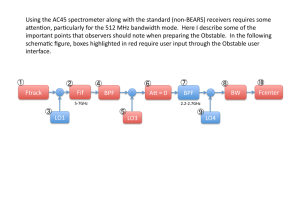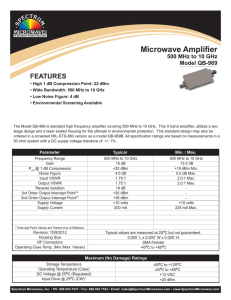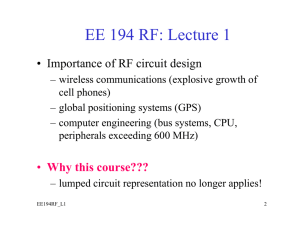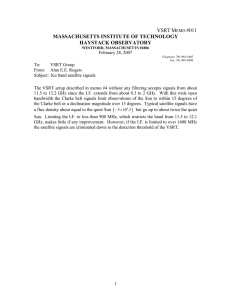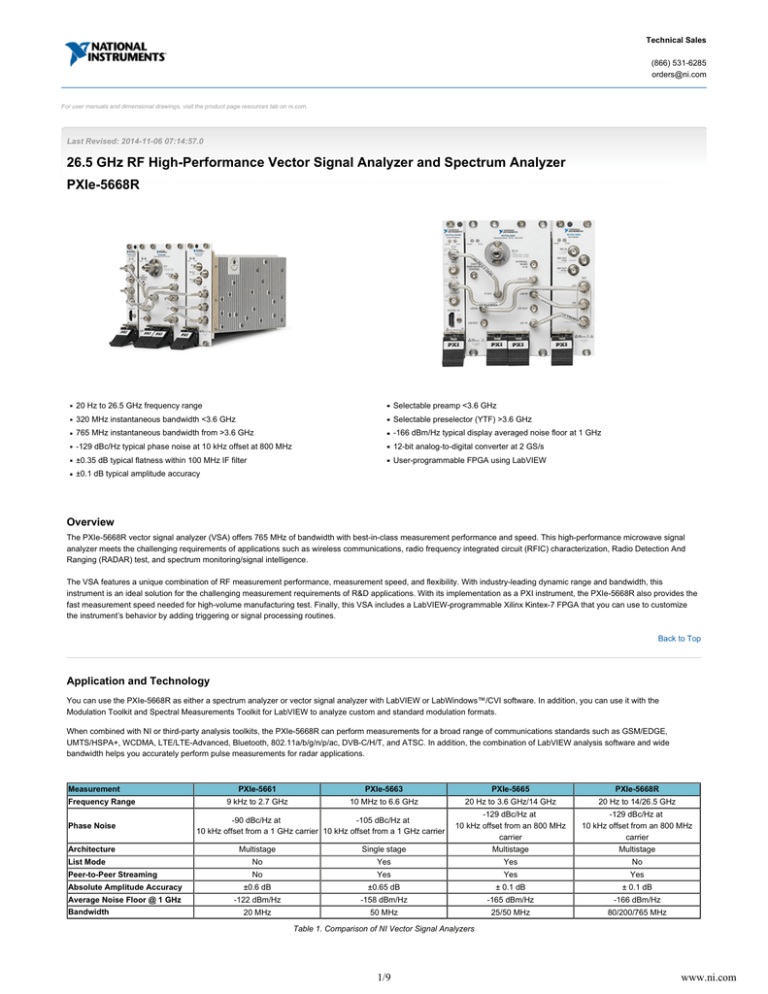
Technical Sales
(866) 531-6285
orders@ni.com
For user manuals and dimensional drawings, visit the product page resources tab on ni.com.
Last Revised: 2014-11-06 07:14:57.0
26.5 GHz RF High-Performance Vector Signal Analyzer and Spectrum Analyzer
PXIe-5668R
20 Hz to 26.5 GHz frequency range
Selectable preamp <3.6 GHz
320 MHz instantaneous bandwidth <3.6 GHz
Selectable preselector (YTF) >3.6 GHz
765 MHz instantaneous bandwidth from >3.6 GHz
-166 dBm/Hz typical display averaged noise floor at 1 GHz
-129 dBc/Hz typical phase noise at 10 kHz offset at 800 MHz
12-bit analog-to-digital converter at 2 GS/s
±0.35 dB typical flatness within 100 MHz IF filter
User-programmable FPGA using LabVIEW
±0.1 dB typical amplitude accuracy
Overview
The PXIe-5668R vector signal analyzer (VSA) offers 765 MHz of bandwidth with best-in-class measurement performance and speed. This high-performance microwave signal
analyzer meets the challenging requirements of applications such as wireless communications, radio frequency integrated circuit (RFIC) characterization, Radio Detection And
Ranging (RADAR) test, and spectrum monitoring/signal intelligence.
The VSA features a unique combination of RF measurement performance, measurement speed, and flexibility. With industry-leading dynamic range and bandwidth, this
instrument is an ideal solution for the challenging measurement requirements of R&D applications. With its implementation as a PXI instrument, the PXIe-5668R also provides the
fast measurement speed needed for high-volume manufacturing test. Finally, this VSA includes a LabVIEW-programmable Xilinx Kintex-7 FPGA that you can use to customize
the instrument’s behavior by adding triggering or signal processing routines.
Back to Top
Application and Technology
You can use the PXIe-5668R as either a spectrum analyzer or vector signal analyzer with LabVIEW or LabWindows™/CVI software. In addition, you can use it with the
Modulation Toolkit and Spectral Measurements Toolkit for LabVIEW to analyze custom and standard modulation formats.
When combined with NI or third-party analysis toolkits, the PXIe-5668R can perform measurements for a broad range of communications standards such as GSM/EDGE,
UMTS/HSPA+, WCDMA, LTE/LTE-Advanced, Bluetooth, 802.11a/b/g/n/p/ac, DVB-C/H/T, and ATSC. In addition, the combination of LabVIEW analysis software and wide
bandwidth helps you accurately perform pulse measurements for radar applications.
Measurement
Frequency Range
Phase Noise
PXIe-5661
PXIe-5663
PXIe-5665
PXIe-5668R
9 kHz to 2.7 GHz
10 MHz to 6.6 GHz
20 Hz to 3.6 GHz/14 GHz
20 Hz to 14/26.5 GHz
-129 dBc/Hz at
10 kHz offset from an 800 MHz
carrier
-129 dBc/Hz at
10 kHz offset from an 800 MHz
carrier
Multistage
-90 dBc/Hz at
-105 dBc/Hz at
10 kHz offset from a 1 GHz carrier 10 kHz offset from a 1 GHz carrier
Architecture
Multistage
Single stage
Multistage
List Mode
No
Yes
Yes
No
Peer-to-Peer Streaming
No
Yes
Yes
Yes
Absolute Amplitude Accuracy
±0.6 dB
±0.65 dB
± 0.1 dB
± 0.1 dB
Average Noise Floor @ 1 GHz
-122 dBm/Hz
-158 dBm/Hz
-165 dBm/Hz
-166 dBm/Hz
50 MHz
25/50 MHz
80/200/765 MHz
Bandwidth
20 MHz
Table 1. Comparison of NI Vector Signal Analyzers
RF Measurement Performance
1/9
www.ni.com
RF Measurement Performance
The PXIe-5668R is a PXI fast Fourier transform (FFT)-based signal analyzer suitable for both high-end spectrum analysis and vector signal analysis. The combination of low
phase noise, low noise floor, and high second- and third-order intercepts provides excellent dynamic range for applications ranging from adjacent channel leakage ratio (ACLR)
measurements to spurs and harmonics measurements. Table 2 illustrates the typical performance of the PXIe-5668R at center frequencies of 1 GHz and 20 GHz.
Measurement
1 GHz
20 GHz
-154 dBm/Hz
-152 dBm/Hz
-166 dBm/Hz
—
IP3 With YIG Tuned Filter
+23 dBm
—
+24 dBm
+28 dBm
Second Harmonic Intercept
+67 dBm
N/A
Image Rejection
-105 dBc
-83 dBc
-129 dBc/Hz
-116 dBc/Hz
320 MHz
765 MHz
Noise Floor (RMS) Without Preamplifier
Noise Floor (RMS) With Preamplifier
IP3 Without YIG Tuned Filter
Phase Noise at 10 kHz Offset
Instantaneous Bandwidth
Table 2. Typical PXIe-5668R Performance
The PXIe-5668R achieves extremely wide instantaneous bandwidth using its 2 GS/s digitizer. As Table 2 shows, the instrument features 320 MHz of instantaneous bandwidth
below center frequencies of 3.6 GHz and up to 765 MHz of instantaneous bandwidth at center frequencies from 3.6 GHz to 26.5 GHz.
Dynamic Range
The superior dynamic range performance of the PXIe-5668R gives it the ability to accurately perform measurements ranging from intermodulation distortion (IMD) to adjacent
channel power (ACP) to error vector magnitude (EVM). In figures 1 and 2, the instrument’s dynamic range chart illustrates both noise and linearity as a function of mixer level.
Figure 1. PXIe-5668R Dynamic Range Chart at 1 GHz, Preamplifier Disabled (Nominal)
2/9
www.ni.com
Figure 2. PXIe-5668R Dynamic Range Chart at 20 GHz, YTF Enabled (Nominal)
In Figure 1, note that the optimal mixer level for most measurements is approximately -36 dBm, where the instrument delivers approximately 119 dB of spurious-free dynamic
range (SFDR) in a 1 Hz bandwidth. At 20 GHz (Figure 2), the PXIe-5668R achieves similar performance with an optimal mixer level of -37 dBm. At this mixer level, the instrument
achieves 115 dB of SFDR in 1 Hz of bandwidth.
A combination of accurate linearity and noise floor is critical when measuring IMD and ACP. In fact, the specification that best represents the ability of an instrument to perform
these measurements is third-order intercept (TOI). The PXIe-5668R has a TOI specification of better than +23 dBm at 1 GHz with 0 dB of attenuation. As Figure 3 illustrates, the
instrument delivers nominal TOI performance of +25 dBm at 1 GHz, 2 dB better than specification.
Figure 3. PXIe-5668R Intermodulation Distortion Measurements
Although the TOI specification of an RF signal analyzer is defined using 0 dB of attenuation by convention, an RF signal analyzer can measure TOI much higher than its
specification. In practice, you can optimize measurement system linearity by switching up to 75 dB of internal attenuation on the PXIe-5668R.
3/9
www.ni.com
In addition to IMD measurements, the high dynamic range of the PXIe-5668R makes it ideal for spectrum measurements such as ACP and ACLR. Figure 4 illustrates an ACLR
measurement of a WCDMA signal and shows an inherent ACLR floor of approximately 85 dB.
Figure 4. PXIe-5668R WCDMA ACLR Performance at 468 MHz
You can use NI wireless standard software toolkits with the PXIe-5668R to make UMTS ACLR measurements as well as test devices using technologies including GSM/EDGE,
UMTS/HSPA+, LTE/LTE-Advanced, Bluetooth, and 802.11a/b/g/n/p/ac.
Wide Instantaneous Bandwidth
The PXIe-5668R supports an instantaneous bandwidth of 320 MHz or 765 MHz, depending on frequency range. The ability to measure extremely wide bandwidths in a single
acquisition is useful for applications ranging from wireless communications test to radar pulse measurements. When you are measuring wideband signals with metrics such as
EVM, make sure that the instantaneous bandwidth of the RF signal analyzer is greater than the bandwidth of the signal. For example, wireless technologies such as the IEEE
802.11ac standard require an instantaneous bandwidth of 160 MHz to perform an EVM measurement. In addition, the spectrum mask requirements for a 160 MHz 802.11ac
signal include limits that are ±240 MHz from the center frequency for a total of 480 MHz of bandwidth. With 765 MHz of instantaneous bandwidth, the PXIe-5668R can perform
measurements such as a 160 MHz spectrum mask in a single acquisition.
Additional applications such as RADAR pulse measurements also require extremely wide instantaneous bandwidth. In a typical RADAR pulse, the frequency domain
characteristics of the signal appear as a sync function containing both a main lobe and theoretically infinite side lobes as shown in Figure 5.
Figure 5. The Main Power Lobe of a 20 ns Pulse Contained Within a Bandwidth of 100 MHz
4/9
www.ni.com
RADAR pulse measurements, such as pulse rise time, require a VSA to capture both the main lobe and several side lobes. A general rule for measuring the pulse rise time of X
nanoseconds is that the instrument’s instantaneous bandwidth must be 3/X. For example, to measure pulse rise times as low as 5 ns, the required instrument instantaneous
bandwidth would be 3/(5 ns) or 600 MHz. In Figure 6, notice that the wide bandwidth of the PXIe-5668R signal analyzer enables extremely accurate pulse rise time
measurements—in this case showing a rise time of 8 ns.
Figure 6. Time Domain of a 20 ns Pulse Using Zero Span Mode
Although the extremely wide bandwidth of the PXIe-5668R is ideal for performing accurate pulse measurements, the wide instantaneous bandwidth also allows faster spectrum
measurements in scenarios where the span is smaller than the instantaneous bandwidth of the instrument.
Flexibility
Another key attribute of the PXIe-5668R RF signal analyzer is the flexibility with which you can reconfigure it. Because the VSA is a LabVIEW FPGA programmable target, you
can embed custom signal processing algorithms on the instrument itself. For example, using LabVIEW example code, you can configure the instrument as a real-time spectrum
analyzer (RTSA). As shown in Figure 7, with the RTSA personality, you can analyze extremely wide bandwidths of spectrum in real time without gaps in the time-domain record.
Figure 7. The real-time spectrum analysis capability of the PXIe-5668R enables unique visualization tools such as the persistence display.
Finally, as a result of this instrument’s modular architecture, additional downconverter and digitizer modules support multichannel receiver configurations. The PXIe-5668R VSA
provides the ability to share the local oscillator and other timing signals across multiple modules and allows for phase coherence between each RF channel. The phase coherence
of multichannel receivers is important in applications ranging from direction finding to beamforming and multiple input, multiple output device testing. Figure 8 shows an example
configuration of a 2-channel RF signal analyzer.
5/9
www.ni.com
Figure 8. You can configure multiple PXIe-5668R instruments for multichannel, phase-coherent RF signal acquisition.
With the configuration shown in Figure 8, you can achieve tight channel-to-channel synchronization in multichannel measurement applications.
Fast Measurement Speed
Using software-defined measurements in the LabVIEW graphical development environment with the PXIe-5668R, you can perform common spectrum and demodulation
measurements 3X to 10X faster than traditional instruments. For example, you can perform a 100 MHz spectrum capture in 2 ms with a PXIe-8135 embedded controller (100 kHz
RBW). Though actual performance is system dependent, Figure 9 shows the relationship between measurement time and span (Hz).
Figure 9. PXIe-5668R Measurement Speed for 320 MHz and 765 MHz Bandwidth Settings With Respect to Span (Hz)
Flexible Software
You can interface the PXIe-5668R with a variety of software experiences including interactive soft front panels and multiple programming APIs.
The NI-RFmx API offers the simplest programming experience for automating RF measurements. With NI-RFmx, you can reduce test system development time by simplifying
complex RF measurement programming. It delivers industry-leading measurement speed and provides higher throughput capabilities than box instruments. Now you can control
parallelism instead of trying to work around the inflexibility of traditional box instruments.
6/9
www.ni.com
One of the biggest benefits of the NI-RFmx API is the breadth of ready-to-run LabVIEW examples. These examples not only demonstrate the simplicity of the API but also enable
you to quickly get started on your automated RF test application. Figure 10 features a simple LabVIEW example showing an ACP measurement.
Figure 10. LabVIEW Example for an ACP Measurement
In addition to programming APIs for automated measurements, you can use the NI-RFSA Soft Front Panel (SFP) for interactive measurements. The SFP mimics the look and feel
of traditional instruments and helps you perform basic measurements without programming. Figure 11 shows an ACP measurement performed in the NI-RFSA SFP.
Figure 11. NI-RFSA SFP Showing an ACP Measurement
Architecture
The PXIe-5668R uses two distinct signal paths to deliver a combination of wide instantaneous bandwidth and best-in-class RF performance. In the low-band path, below 3.6 GHz,
the instrument uses a three-stage superheterodyne design with optional preamplification. In the high-band path, above 3.6 GHz, the instrument uses a two-stage design with a
selectable yttrium-iron-garnet (YIG)-tuned filter (YTF) for preselection.
In the low band of the PXIe-5668R (3.6 GHz shown in Figure 12), the instrument contains several features to improve measurement performance. Figure 12 highlights a simplified
block diagram. Note that you can engage the 30 dB preamplifier to reduce the instrument’s inherent noise floor when measuring low-level signals.
7/9
www.ni.com
Figure 12. Simplified Block Diagram of the PXIe-5668R
Figure 12 also illustrates two highpass filters before the first mixing stage. You can engage these filters with a highpass cutoff of 1,350 MHz and 2,200 MHz to suppress the
fundamental frequency of common cellular communications bands around 1 GHz. With filters enabled, the instrument can more accurately measure low-level second and third
harmonics at approximately 2 GHz and 3 GHz, respectively.
In the high band, above 3.6 GHz, a YTF functions as a preselector for operation from 3.6 GHz to 26.5 GHz, which is enabled by default for spectrum measurements. For
extremely wideband vector signal analysis, you can disable the YTF to use the full 765 MHz of instantaneous bandwidth.
Flexible IF Structure
Used with a 2 GS/s digitizer sample rate, the VSA’s downconverter has a flexible IF structure that allows both high-end spectrum analysis and wideband vector signal analysis.
For example, you can engage a narrow 300 kHz analog filter to facilitate measurements requiring the highest dynamic range, such as two-tone IMD or ACLR. For vector signal
analysis, you can disable the IF filtering entirely to allow for bandwidths of up to either 320 MHz or 765 MHz, depending on the center frequency.
The PXIe-5624R digitizer’s wideband analog front end is optimized for superheterodyne receiver architectures. It features an onboard digital downconverter which filters,
decimates, and shifts complex IF signals to baseband data centered at 0 Hz. As a result, you can use the PXIe-5624R either as part of the PXIe-5668R VSA or as a stand-alone
IF digitizer.
Summary
The PXIe-5668R is a high-performance 26.5 GHz VSA that is ideal for a wide range of applications. The combination of superior analog performance, extremely wide bandwidth,
and ultimate flexibility empowers you to solve challenging measurement applications ranging from ACLR measurements to RADAR verification to spectrum monitoring.
Find more information on the PXIe-5668R at ni.com/microwave.
Back to Top
Support and Services
System Assurance Programs
NI system assurance programs are designed to make it even easier for you to own an NI system. These programs include configuration and deployment services for your NI PXI,
CompactRIO, or Compact FieldPoint system. The NI Basic System Assurance Program provides a simple integration test and ensures that your system is delivered completely
assembled in one box. When you configure your system with the NI Standard System Assurance Program, you can select from available NI system driver sets and application
development environments to create customized, reorderable software configurations. Your system arrives fully assembled and tested in one box with your software preinstalled.
When you order your system with the standard program, you also receive system-specific documentation including a bill of materials, an integration test report, a recommended
maintenance plan, and frequently asked question documents. Finally, the standard program reduces the total cost of owning an NI system by providing three years of warranty
coverage and calibration service. Use the online product advisors at ni.com/advisor to find a system assurance program to meet your needs.
Calibration
NI measurement hardware is calibrated to ensure measurement accuracy and verify that the device meets its published specifications. To ensure the ongoing accuracy of your
measurement hardware, NI offers basic or detailed recalibration service that provides ongoing ISO 9001 audit compliance and confidence in your measurements. To learn more
about NI calibration services or to locate a qualified service center near you, contact your local sales office or visit ni.com/calibration.
Technical Support
Get answers to your technical questions using the following National Instruments resources.
Support - Visit ni.com/support to access the NI KnowledgeBase, example programs, and tutorials or to contact our applications engineers who are located in NI sales
offices around the world and speak the local language.
Discussion Forums - Visit forums.ni.com for a diverse set of discussion boards on topics you care about.
Online Community - Visit community.ni.com to find, contribute, or collaborate on customer-contributed technical content with users like you.
Repair
While you may never need your hardware repaired, NI understands that unexpected events may lead to necessary repairs. NI offers repair services performed by highly trained
technicians who quickly return your device with the guarantee that it will perform to factory specifications. For more information, visit ni.com/repair.
Training and Certifications
8/9
www.ni.com
Training and Certifications
The NI training and certification program delivers the fastest, most certain route to increased proficiency and productivity using NI software and hardware. Training builds the skills
to more efficiently develop robust, maintainable applications, while certification validates your knowledge and ability.
Classroom training in cities worldwide - the most comprehensive hands-on training taught by engineers.
On-site training at your facility - an excellent option to train multiple employees at the same time.
Online instructor-led training - lower-cost, remote training if classroom or on-site courses are not possible.
Course kits - lowest-cost, self-paced training that you can use as reference guides.
Training memberships and training credits - to buy now and schedule training later.
Visit ni.com/training for more information.
Extended Warranty
NI offers options for extending the standard product warranty to meet the life-cycle requirements of your project. In addition, because NI understands that your requirements may
change, the extended warranty is flexible in length and easily renewed. For more information, visit ni.com/warranty.
OEM
NI offers design-in consulting and product integration assistance if you need NI products for OEM applications. For information about special pricing and services for OEM
customers, visit ni.com/oem.
Alliance
Our Professional Services Team is comprised of NI applications engineers, NI Consulting Services, and a worldwide National Instruments Alliance Partner program of more than
700 independent consultants and integrators. Services range from start-up assistance to turnkey system integration. Visit ni.com/alliance.
Back to Top
©2014 National Instruments. All rights reserved. CVI, LabVIEW, National Instruments, NI, ni.com, and NI FlexRIO are trademarks of National Instruments. The mark LabWindows is used
under a license from Microsoft Corporation. Windows is a registered trademark of Microsoft Corporation in the United States and other countries. Other product and company names listed are
trademarks or trade names of their respective companies.
My Profile | RSS | Privacy | Legal | Contact NI © 2014 National Instruments Corporation. All rights reserved.
9/9
www.ni.com


